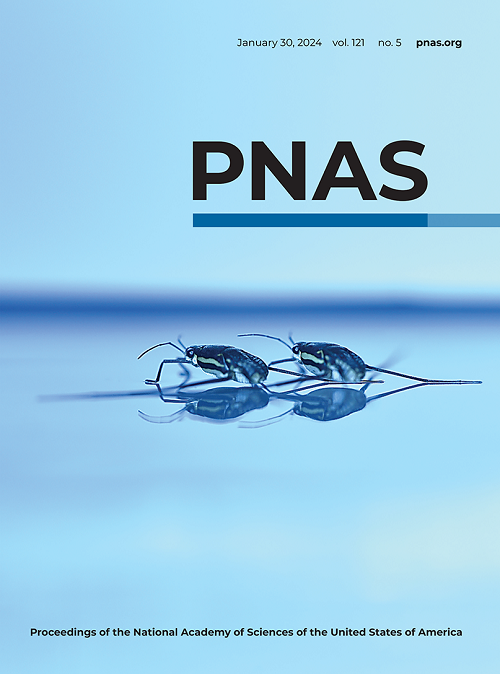ATM priming and end resection–coupled phosphorylation of MRE11 is important for fork protection and replication restart
IF 9.4
1区 综合性期刊
Q1 MULTIDISCIPLINARY SCIENCES
Proceedings of the National Academy of Sciences of the United States of America
Pub Date : 2025-04-18
DOI:10.1073/pnas.2422720122
引用次数: 0
Abstract
The MRE11/RAD50/NBS1 (MRN) complex plays multiple roles in the maintenance of genome stability. MRN is associated with replication forks to preserve fork integrity and is also required for end resection at double-strand breaks (DSBs) to facilitate homologous recombination (HR). The critical need for proper control of the MRE11 nuclease activity is highlighted by the extensive nascent strand DNA degradation driven by MRE11 in BRCA-deficient cells, leading to genome instability and increased sensitivity to chemotherapeutics. In this study, we identified a tightly controlled mechanism, elicited by sequential phosphorylation of MRE11 by ATM and ATR to regulate MRE11 nuclease activities through its DNA binding. Specifically, at DSBs, MRE11 phosphorylation by ATM at the C-terminal S676/S678 primes it for subsequent phosphorylation by ATR, whose activation is triggered by end resection which requires the MRE11 nuclease activity. This ATR-mediated phosphorylation in turn induces MRE11 dissociation from DNA, providing a feedback mechanism to regulate the extent of end resection. At stalled replication forks, however, without ATM priming, MRN is stably associated with forks despite ATR activation. Furthermore, the ATR phosphorylation–defective MRE11 mutants are retained at single-ended DSBs formed by fork reversal upon replication stress, leading to extensive degradation of nascent DNA strands. Importantly, this end resection–coupled MRE11 phosphorylation elicits another critical layer of fork protection of nascent DNA in addition to BRCA2, ensuring proper end resection that is sufficient for replication restart at reversed forks while maintaining fork stability.ATM启动和末端切除耦合的MRE11磷酸化对分叉保护和复制重启很重要
MRE11/RAD50/NBS1 (MRN)复合体在维持基因组稳定性中发挥着多种作用。MRN与复制叉相关,以保持叉的完整性,并且在双链断裂(dsb)的末端切除中也需要MRN,以促进同源重组(HR)。在brca缺陷细胞中,由MRE11驱动的广泛的新生链DNA降解,导致基因组不稳定和对化疗药物的敏感性增加,强调了对MRE11核酸酶活性的适当控制的迫切需要。在这项研究中,我们发现了一个严格控制的机制,通过ATM和ATR对MRE11的顺序磷酸化,通过其DNA结合来调节MRE11核酸酶的活性。具体来说,在dsb中,ATM在c端S676/S678对MRE11的磷酸化为ATR随后的磷酸化做准备,ATR的激活是通过末端切除触发的,这需要MRE11核酸酶的活性。这种atr介导的磷酸化反过来诱导MRE11与DNA分离,提供了一种反馈机制来调节末端切除的程度。然而,在没有ATM启动的停滞复制分叉中,尽管ATR激活,MRN仍稳定地与分叉相关联。此外,ATR磷酸化缺陷的MRE11突变体保留在复制胁迫下叉反转形成的单端dsb中,导致新生DNA链的广泛降解。重要的是,除了BRCA2外,这种末端切除偶联的MRE11磷酸化引发了新生DNA的另一个关键叉保护层,确保适当的末端切除足以在反向叉处重新开始复制,同时保持叉的稳定性。
本文章由计算机程序翻译,如有差异,请以英文原文为准。
求助全文
约1分钟内获得全文
求助全文
来源期刊
CiteScore
19.00
自引率
0.90%
发文量
3575
审稿时长
2.5 months
期刊介绍:
The Proceedings of the National Academy of Sciences (PNAS), a peer-reviewed journal of the National Academy of Sciences (NAS), serves as an authoritative source for high-impact, original research across the biological, physical, and social sciences. With a global scope, the journal welcomes submissions from researchers worldwide, making it an inclusive platform for advancing scientific knowledge.

 求助内容:
求助内容: 应助结果提醒方式:
应助结果提醒方式:


